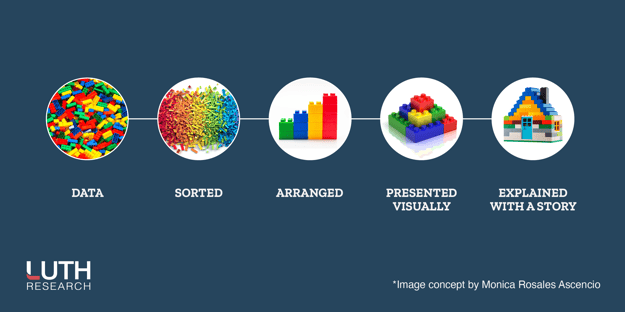You’ve completed the large market research project and gained many insights to share with your team. Now, how do you present it in a way that each department will take away what is most relevant to their strategies? That may be the hardest part of the whole project. The sales team will look for different information than your R&D department so making sure you present according to your audience will guarantee you get the budget for market research projects again next year.
Here Are a Few Things to Keep in Mind:
1. Know your audience
As stated above, who you are presenting to is important. Prioritize what the key findings are for each target. What does my audience need to know most? Sales may look for bulleted highlights called out or buyer personas identified, R&D wants details that dive deeper into the numbers or market evaluation.
2. Visualization matters

This image is a perfect example of how important visualization is. How do we go from the “Data” to the “Actionable”? At Luth Research we collect digital data and those results, although incredibly insightful, can be a bit overwhelming, like a dump of the entire lego box. We work with our clients to flush out the level of complexity that comes with shopper insight data like search terms used, behaviors on specific websites, cart activity, etc. We sift through it to create a very dense and meaty deck. This needs to be the starting point (“Presented Visually” in our Lego example). This allows us to see the data in all its glory. Then we can move to the other levels of visualization like the house.
3. Create a Story
A visualization is only as good as the story that accompanies it. The goal will be to present a story that’s both easy to understand and has the facts to back up this valuable consumer data.
Just like the stories you had to write in school, your shopper insight data or other market research findings will need a beginning, middle and end with conflict resolution. Nancy Duarte in a Harvard Business Review article sums this up perfectly:
After studying hundreds of speeches, I’ve found that the most effective presenters use the same techniques as great storytellers: By reminding people of the status quo and then revealing the path to a better way, they set up a conflict that needs to be resolved.
She goes on to say,
That tension helps them persuade the audience to adopt a new mindset or behave differently — to move from what is to what could be. And by following Aristotle’s three-part story structure (beginning, middle, end), they create a message that’s easy to digest, remember, and retell.
4. Outline the Actions
Your story resolution comes when you offer the actions that need to be taken using this insight data. Keep the actions simple and easy to understand. Offer a bulleted takeaway for each department so they can refer back and be reminded of how to use this data driven information for future decision making.
5. Research Partner
For 45 years, Luth Research has helped clients take that messy pile of legos and turn it into an amazing story that allows for smart, data driven decision making. As the industry-leading path-to-purchase market research firm powered by a revolutionary behavioral data collection technology. Our broad range of online participants delivers timely data that provides clear insights into what consumers feel, say and actually do. Revenue-focused brands partner with Luth Research to understand the consumer journey in a way that delivers a competitive advantage.
Do you have a research partner that you trust and feel confident in? Luth Research will guide you through the weeds to get to the most important data insights that your team can use the most to move your business forward.



